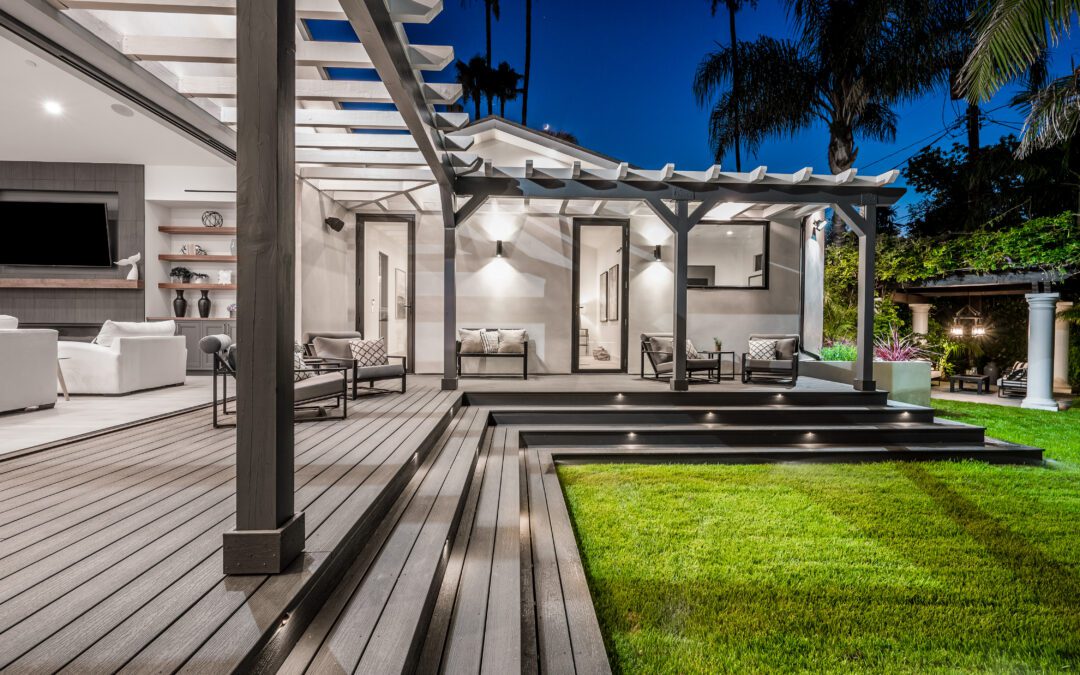When planning a new deck, size matters. Too small and it feels cramped. Too large and it may overwhelm the yard or eat up your budget. The right size strikes a balance between how you want to use the space, how much room you have, and what fits the style of your home.
Choosing the right deck size is one of the most important decisions in the design process. It affects everything from functionality to appearance to resale value. Whether you are replacing an old deck or starting from scratch, this guide will help you figure out what size is right for your space.
Start with How You Plan to Use the Deck
The best way to begin is by thinking about what you want to do on the deck. Different uses require different amounts of space.
Here are some common uses and the space they need
Small dining area
A four person table with chairs typically needs a space about ten feet by ten feet.
Larger dining or lounge area
If you plan to seat six to eight people or add a sectional and coffee table, aim for at least twelve to sixteen feet in one direction.
Grill and prep space
A grill station with room to move around it comfortably takes about six feet by six feet. Add more space if you want built in counters or cabinets.
Multiple zones
Decks with separate areas for eating, cooking, and lounging will need clear divisions and more square footage. Many multi use decks start at two hundred square feet and up.
Hot tub
If you plan to add a hot tub, plan for its footprint plus enough room for access, stairs, and seating nearby. A standard hot tub takes about seventy five square feet on its own.
Consider the Size and Shape of Your Yard
The deck should fit well into your outdoor space and leave enough room for other activities. A good rule of thumb is that the deck should not take up more than one third to one half of the total yard area unless you have a very small or sloped lot.
Also think about
- The slope of the yard and how much leveling is required
- Existing landscaping or trees you want to keep
- Space for pathways, sheds, or garden beds
In tight spaces, a compact deck that is well designed often feels better than a large one that crowds everything else out.
Think About the Size of Your Home
A deck that looks great on one house might feel out of place on another. The deck should match the proportions of your home and blend with its style.
For example
- A deck that spans the entire width of a small home can look too large
- A tiny deck on a large home may look unbalanced and feel underused
- Multi level homes often benefit from tiered decks that match the layout
Our team looks at how the deck connects to your home so the transition feels natural and clean. We want the new space to feel like it has always been there.
Measure Common Furniture Pieces Before You Build
Decks need more space than just the furniture’s footprint. People need to move around, open doors, and use the space comfortably.
Here are some typical clearances to keep in mind
- Three feet of space around a table for chairs to pull out
- Two to three feet between furniture and railings
- Four to five feet of walking space in high traffic areas
- At least three feet of space between a grill and any walls or railings
If you already own patio furniture or plan to buy new pieces, measure them before finalizing the layout. This prevents surprises after construction.
Don’t Forget Vertical Space
Deck size is not only about square footage. Vertical features like railings, pergolas, privacy screens, and planters affect how spacious the deck feels.
A small deck with open views and simple railings can feel much bigger than it is. On the other hand, a larger deck with built in walls or heavy coverings can feel more enclosed.
We help our clients create decks that feel roomy and open without taking over the whole yard.
Add Space Where It Matters Most
If your budget is tight or the yard has size limits, consider where space matters most.
- Prioritize space near doorways for easy flow
- Add depth instead of width to make long spaces feel more usable
- Create corners or bump outs for planters or chairs
- Use stairs to create access to other parts of the yard without needing a larger top platform
Good design makes even small decks feel generous when space is used wisely.
Know the Rules in Your Area
Most municipalities in British Columbia have building code requirements about deck height, setbacks, and maximum coverage. These rules may limit how large or tall your deck can be, especially if your yard is close to a property line or other structures.
At All Hands on Deck, we manage the permit process for you. We make sure your deck is designed to fit within legal guidelines while still meeting your goals.
Consider Future Use
Even if you only need a small deck now, it is worth thinking about how your needs may change in a few years.
- Will you want to entertain more people later
- Do you plan to upgrade your furniture or add a hot tub
- Are you thinking about selling the home within a few years
A deck that can adapt to changing use is a better investment. When possible, we design decks that allow future additions like railings, covers, or added levels.
Typical Deck Sizes We Build
Here are a few examples of common deck sizes that work well for different homes
- 120 to 160 square feet
Good for small homes or townhouses. Enough space for a table and grill or a couple of lounge chairs. - 200 to 300 square feet
Works well for most mid sized homes. Allows space for a dining set, grill, and small lounge area. - 300 to 400 square feet
Great for entertaining. Offers room for multiple zones and larger furniture setups. - 400 square feet and up
Used for large or multi level homes, or yards with a strong view. Can include covered areas, hot tubs, and more custom features.
Need help deciding the right size for your deck? Contact All Hands on Deck for a site visit and expert advice based on your yard and your goals.



Recent Comments